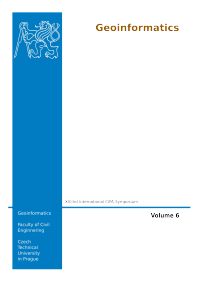Improving Completeness of Geometric Models from Terrestrial Laser Scanning Data
DOI:
https://doi.org/10.14311/gi.6.29Keywords:
laser scanning, modeling, cultural heritage, automation, documentation, triangulationAbstract
The application of terrestrial laser scanning for the documentation of cultural heritage assets is becoming increasingly common. While the point cloud by itself is sufficient for satisfying many documentation needs, it is often desirable to use this data for applications other than documentation. For these purposes a triangulated model is usually required. The generation of topologically correct triangulated models from terrestrial laser scans, however, still requires much interactive editing. This is especially true when reconstructing models from medium range panoramic scanners and many scan positions. Because of residual errors in the instrument calibration and the limited spatial resolution due to the laser footprint, the point clouds from different scan positions never match perfectly. Under these circumstances many of the software packages commonly used for generating triangulated models produce models which have topological errors such as surface intersecting triangles, holes or triangles which violate the manifold property. We present an algorithm which significantly reduces the number of topological errors in the models from such data. The algorithm is a modification of the Poisson surface reconstruction algorithm. Poisson surfaces are resilient to noise in the data and the algorithm always produces a closed manifold surface. Our modified algorithm partitions the data into tiles and can thus be easily parallelized. Furthermore, it avoids introducing topological errors in occluded areas, albeit at the cost of producing models which are no longer guaranteed to be closed. The algorithm is applied to scan data of sculptures of the UNESCO World Heritage Site Schönbrunn Palace and data of a petrified oyster reef in Stetten, Austria. The results of the method’s application are discussed and compared with those of alternative methods.References
P. Dorninger and C. Nothegger, “Automated Processing of Terrestrial Mid-Range Laser Scanner Data for Restoration Documentation at Millimeter Scale,” Proceedings of the 14th International Congress “Cultural Heritage and New Technologies,” Vienna, Austria: 2009.
H. Edelsbrunner and E.P. Mücke, “Three-dimensional Alpha Shapes,” 1994.
N. Amenta, S. Choi, and R.K. Kolluri, “The Power Crust,” Proceedings of the sixth ACM symposium on solid modeling and applications, Ann Arbor, Michigan, United States: ACM, 2001, pp. 249-266.
B. Curless and M. Levoy, “A Volumetric Method for Building Complex Models from Range Images,” Proceedings of the 23rd annual conference on Computer graphics and interactive techniques, ACM, 1996, pp. 303-312.
H. Hoppe, “Surface Reconstruction from Unorganized Points,” PhD Thesis, University of Washington, 1994.
M. Bolitho, M.M. Kazhdan, R.C. Burns, and H. Hoppe, “Parallel Poisson Surface Reconstruction.,” ISVC (1), G. Bebis, R.D. Boyle, B. Parvin, D. Koracin, Y. Kuno, J. Wang, R. Pajarola, P. Lindstrom, A. Hinkenjann, M.L. Encarnação, C.T. Silva, and D.S. Coming, Eds., Springer, 2009, pp. 678-689.
M. Kazhdan, M. Bolitho, and H. Hoppe, “Poisson surface reconstruction,” Proceedings of the fourth Eurographics symposium on Geometry processing, Eurographics Association Aire-la-Ville, Switzerland, Switzerland, 2006, pp. 6170.
C. Nothegger and P. Dorninger, “3D filtering of high-resolution terrestrial laser scanner point clouds for cultural heritage documentation,” Photogrammetrie, Fernerkundung, Geoinformation (PFG), vol. 1, 2009.
D.C. Hoaglin, F. Mosteller, and J.W. Tukey, Understanding Robust and Exploratory Data Analysis, WileyInterscience, 2000.
C. Nothegger and P. Dorninger, “Automated Modeling of Surface Detail from Point Clouds of Historical Objects,” 21st CIPA Symposium, Anticipating the Future of the Cultural Past, The Internationa l Archives of Photogrammetry, Remote Sensing and Spatial Information Sciences, Athens: 2007, pp. 538 - 543.
P.J. Rousseeuw and K. van Driessen, “A Fast Algorithm for the Minimum Covariance Determinant Estimator,” Technometrics, vol. 41, 1999, pp. 212-223.
B. Li, R. Schnabel, R. Klein, Z. Cheng, G. Dang, and J. Shiyao, “Robust normal estimation for point clouds with sharp features,” Computers & Graphics, vol. 34, Apr. 2010, pp. 94-106.
B.J. Noye and R.J. Arnold, “Accurate finite difference approximations for the Neumann condition on a curved boundary,” Applied Mathematical Modelling, vol. 14, Jan. 1990, pp. 2-13.
A. Toselli and O. Widlund, Domain Decomposition Methods, Springer, 2004.
Downloads
Published
Issue
Section
License
- Authors retain copyright and grant the journal right of first publication with the work simultaneously licensed under a Creative Commons Attribution License that allows others to share the work with an acknowledgement of the work's authorship and initial publication in this journal.
- Authors are able to enter into separate, additional contractual arrangements for the non-exclusive distribution of the journal's published version of the work (e.g., post it to an institutional repository or publish it in a book), with an acknowledgement of its initial publication in this journal.
- Authors are permitted and encouraged to post their work online (e.g., in institutional repositories or on their website) prior to and during the submission process, as it can lead to productive exchanges, as well as earlier and greater citation of published work (See The Effect of Open Access).

